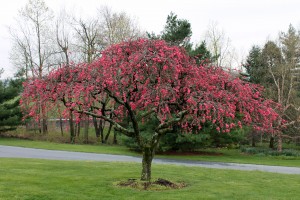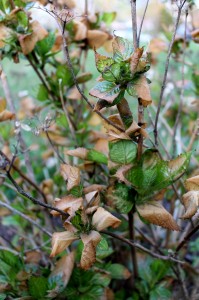Can This Last?
April 3rd, 2012
We made it through March with no kill-off-the-tender-stuff cold snaps, and this week’s forecast is looking frost-free as well.

Heng Lim's unusual double-flowered weeping 'Pink Cascade' peach tree is blooming already in Derry Twp., about three weeks ahead of schedule.
Can we pull off this super-early start to the growing season?
Every day we inch closer to May is one step closer to safety and getting away with a scam against Mother Nature.
We’d better slide into real spring now because most of our plants are far enough long that they’re vulnerable to overnight lows in the 20s.
By vulnerable I mean we’d probably see a lot of young tree and shrub leaves turn to mush, some perennials partially die back, and some fruit buds freeze and die.
The most serious of those is the fruit-bud issue. When fruit buds open and begin to set fruit, a freeze can abort the whole process and lead to little or no fruit.
It won’t harm the tree, but fruit trees and fruit bushes don’t have a fruity backup plan. They get one shot at producing fruit a year, and when something goes wrong, they have to wait for the next cycle and the next year.
This is why fruit-growers have bad nerves.
It’s a bummer when a home gardener doesn’t get any peaches or apricots, but when your entire year’s income is hanging on whether the temperature goes down to 20 degrees next week, that’s a very big deal.
Most landscape plants, on the other hand, do have backup plan.
I was talking about that this week to Annette MaCoy, the Master Gardener coordinator over at Cumberland County Extension, and she points out that plants are a lot more resilient than people give them credit for.
She says a lot of gardeners are apparently worried that a cold snap will come along and kill off their plants.
No need to worry about that.
Even if branch tips freeze, leaves brown out and perennials die back, they’ll almost all recover just fine.
Woody plants will push out new buds and leaves, and perennials will send up new shoots.
“It will set them back, but it won’t kill them,” MaCoy says.
I saw a bit of that already in my yard after that sub-freezing night we had about a week ago.
It was cold enough that some of the leaves on a few of my hydrangeas browned and curled, and some of my baby cauliflower transplants wilted back.
The hydrangeas will replace those leaves in a matter of weeks, and the cauliflower plants are already sending out tiny new leaves out the top of the stem.
The whole rest of the landscape weathered the frost no problem.
So even though we’re a good three weeks ahead of schedule plant-development-wise, I’m not worried at all about mild frosts from here on out. In an average year, we can expect them until April 25. Our all-time latest killing frost in Harrisburg was May 11, although outlying areas have had frosts into late May.
The real problem would be a big nosedive into the mid-20s or below. That’s certainly not out of the question.
In 1982, the nighttime low on April 7 went down to 19 degrees.
Then again, in 2010, the daytime high on April 7 went up to 87 degrees, so who knows?
We gardeners will just take what we get and roll with the punches.








